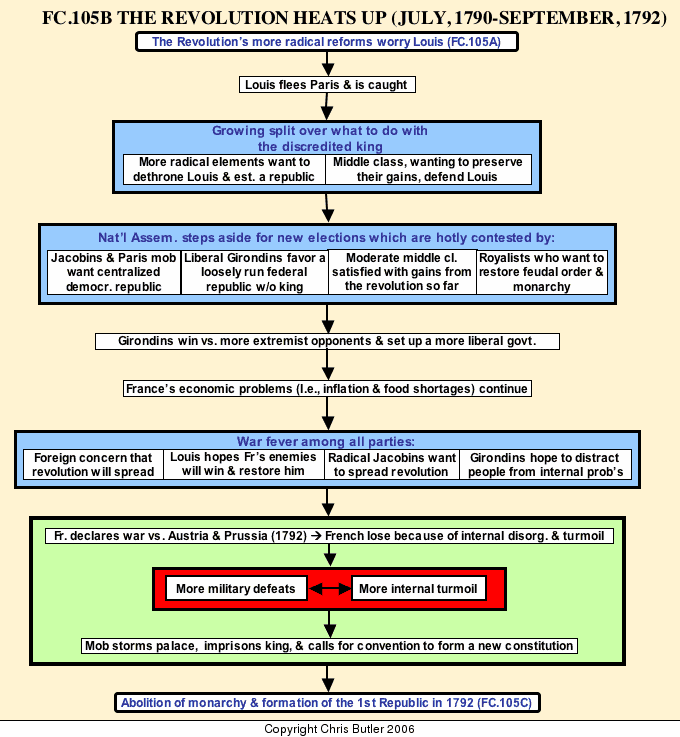FC105BThe Revolution Heats Up (July, 1790-- Sept., 1792)
At the first annual celebration of the revolution 50,000 National Guardsmen from all over France and 300,000 Parisians witnessed the king taking an oath of loyalty to the new constitution. However, Louis was not loyal to the revolution since it severely restricted his power and even prevented him from leaving Paris to attend Mass in the country. On June 20, 1791, the king tried to escape to the Austrian Netherlands and seek refuge with the Hapsburgs. Unfortunately for Louis, everything went wrong. Detachments of royal troops failed to meet him in time. Then, despite Louis' disguise as a German servant, a postmaster at Varennes recognized him from his portrait on the assignats. The postmaster called out the National Guard who captured Louis and escorted him back to Paris. Whatever faith most people may have had in their king before was now shattered by his attempted betrayal of the revolution.
Louis' foiled flight was a turning point in the revolution. First, it further alarmed foreign royalty about the mounting revolutionary threat in France. Second, it widened the rift between the radicals who wanted a republic (democracy without a king) and the bourgeoisie (upper middle class) who wanted to keep the king as figurehead to maintain the moderate respectable image of the revolution. To protect Louis and their position, they claimed the king had not fled but had been kidnapped. At the same time they suspended Louis' powers. But the damage had been done. In July, a demonstration of 50,000 Parisians demanding Louis's abdication turned violent and the National Guard killed 50 demonstrators. The revolution was starting to fragment.
On September 30, 1791 the National Assembly dissolved itself after over two years of leading the revolution. One of its last acts was to exclude its members from re-election to the new National Assembly, thus bringing in new blood, but also eliminating many experienced leaders from participation as well.
The elections of 1791 showed how fragmented the revolution was becoming. On the left wing (sitting to the left of the speaker's platform in the assembly) were the radicals led by the Jacobins who wanted a more strongly centralized republic. Next to them and controlling the most votes were the Girondins who also favored a republic, but with more provincial freedom from central control in Paris. Just to the right of them were moderates who were happy with their gains from the revolution and resisted further change. To the far right were the monarchists who wanted to restore the feudal order and the king's power. These were not so much organized political parties as they were loosely organized networks of political clubs united by a common political philosophy.
While the Girondins had been able to exploit the moderates' problems in order to gain power, they soon found themselves faced with the old issues of food shortages, inflation, and debt. A new problem was also surfacing that would soon overshadow the rest: war. Ironically, this was the one issue most people agreed on, but for widely different reasons. Louis and the monarchists saw war as a chance for Austria and Prussia to crush the revolution and restore the king to power. The Girondins saw it as an opportunity to discredit Louis and spread the revolution across Europe. War could also divert attention from France's internal problems. Many Frenchmen saw war as a means of preventing nobles from returning to reclaim their lands and feudal rights. Austria and Prussia wanted war to prevent the revolution from spreading outside of France. With everyone in such agreement, France declared war on Austria and Prussia (4/20/1792). This triggered a series of wars between France and the rest of Europe that would last, with few breaks, for 23 years.
The government was optimistic about the war. It should have known better. The combination of old and new debts plus inflation triggered by the assignats had left the treasury in shambles. Likewise, the incomplete transition from the royalist army to a national one had left the army in disarray. Royalist and National Guard units operated separately from one another. Noble officers had either fled or were of suspect loyalty. And the troops, while enthusiastic, were poorly trained, supplied, and led.
The result was a total fiasco as French troops fled at the first sight of the enemy. Charges of treason flew everywhere, especially against Louis, who probably was plotting with the enemy. An ultimatum ordering the French not to harm the king seemed to confirm suspicions of his guilt. On August 10, 1792, 9000 Parisians and National Guard troops stormed Louis' palace of the Tuileries. Louis, hating the sight of his own people's blood being shed, ordered his Swiss Guards to cease-fire. The mob massacred the guard, looted the palace, and turned Louis over to the Paris Commune who threw him into jail. The National Assembly, under heavy pressure from the sans culottes, agreed to new elections for a convention to form a new constitution. The monarchy was abolished and replaced by The First Republic, which would see the revolution through its trial by fire.
